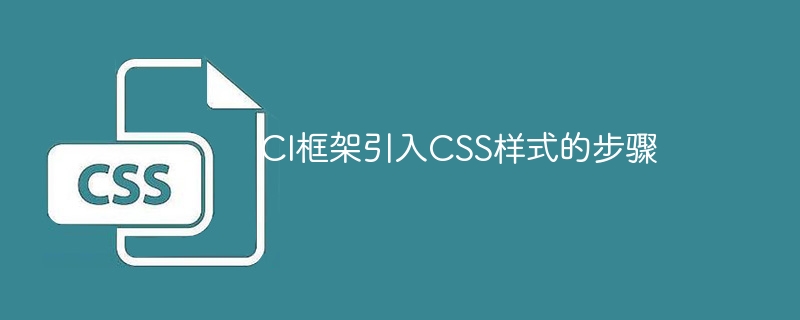

The steps for CI framework to introduce CSS styles require specific code examples
CI (CodeIgniter) framework is a popular PHP development framework that is widely used to build efficient web application. When developing web applications, a beautiful user interface is an important consideration. Using CSS styles can optimize and personalize the web application interface, giving users a better experience. In a CI framework, introducing CSS styles usually requires the following steps, accompanied by specific code examples.
Step 1: Create a CSS file
First, we need to create a CSS file. You can create a new CSS folder under the resources directory of the CI framework and create a stylesheet file named style.css in it. You can use CSS rules to define the style of page elements according to your own needs. The following is an example of a simple style.css file:
body {
font-family: Arial, sans-serif;
background-color: #f1f1f1;
}
h1 {
color: #333333;
}
.container {
max-width: 960px;
margin: 0 auto;
padding: 20px;
background-color: #ffffff;
}
.button {
display: inline-block;
padding: 10px 20px;
background-color: #007bff;
color: #ffffff;
text-decoration: none;
border-radius: 5px;
}Step 2: Set the configuration file
In the CI framework, there is a configuration file named config.php where you can set global Project configuration. Open the application/config/config.php file, and after the "base_url" configuration, add the following code:
$config['css_path'] = base_url() . 'css/';
In this way, we can use the path "css/" as a global variable, which is more convenient to reference in other places. .
Step 3: Introduce CSS into the view file
In the CI framework, view files are usually saved in the application/views/ folder. Open the view file that needs to introduce CSS styles. You can use the following code to introduce CSS styles:
<link rel="stylesheet" type="text/css" href="<?php echo $this->config->item('css_path'); ?>style.css">The above code uses the $config array of the CI framework and obtains the "css_path" configuration in the global configuration by calling the item() method. The value of the item and set it as the href attribute value to the tag.
Step 4: Run the application
After completing the above steps, save the file and run the CI application. Visit the corresponding page in the browser, and the application will successfully introduce the style.css file and apply the style rules defined in it.
It should be noted that the above are just the basic steps for introducing CSS styles into the CI framework. The specific path and file name can be adjusted according to the project situation. In addition, if you need to introduce multiple CSS files, just add multiple tags in the view file.
Summary:
Through the above steps, we can easily introduce CSS styles into the CI framework to add a beautiful and personalized appearance to the web application. At the same time, by writing reasonable CSS rules, the readability and user experience of the page can also be improved. I hope the steps and code examples for introducing CSS styles into the CI framework provided in this article will be helpful to you.
The above is the detailed content of Steps to introduce CSS styles to web pages using CI framework. For more information, please follow other related articles on the PHP Chinese website!




